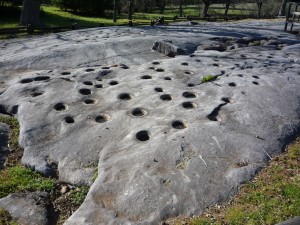I’m pleased to see that the governor signed AB 52 (Gatto), a significant reform to both the California Environmental Quality Act (CEQA) and the state’s attitude toward its diverse Native American tribes. For years, I’ve been shocked to see California’s rich heritage of historical and sacred sites bulldozed for new development, with little fanfare or protection. Here’s an example from near where I grew up in Lafayette, when a major new village site was discovered and dismantled for luxury homes back in 2004:
With at least as many Native American remains and artifacts — including projectile points, stone mortars and beads — still hidden beneath what soon will be two dozen upscale homes, experts say they may have discovered one of the region’s last large, and largely intact, Indian burial sites.
“I would not be surprised if in the inner Bay Area … I never saw another one of this caliber for the rest of my career,” said Allen Pastron, an urban archaeologist from Oakland who is leading the dig.
Unfortunately, many people simply don’t care about these priceless resources. But that’s unfortunate. We all have a stake in preserving these sites, not just Native Americans. I spent the early part of my legal career working with Native Americans at a nonprofit dedicated to helping resolve intra-tribal disputes, and I appreciate the commonly expressed sentiment that these are their sovereign sites, often with strong religious meaning for practices that aren’t just historical but carry on to the present.
As a non-Native, however, my perspective is sympathetic but different. I view these sites as part of all of our human history and legacy, and we should preserve them to educate future generations about our diversity, history and cultural practices. Once they are gone, they are gone forever — and lost is an opportunity to appreciate the 13,000 years of human history in California. Not to mention the opportunity to learn about different ways of managing our natural resources.
CEQA should theoretically provide protections for these sites. But the protections are often weak and unenforced. AB 52 remedies that in key ways. First, it changes the definition of the tribal resource to be protected, opening it up to include landscapes, places and objects that aren’t just within the current political boundaries of the related tribe but within the historic and cultural range of that tribe. The lead agency will have to consult with that affected tribe and determine feasible mitigation measures.
Second, for the first time, the law includes non-federally recognized tribes in California as having a stake in these cultural resources. Currently, there are 110 federally recognized tribes in California and 78 tribal communities petitioning for recognition. Many of those unrecognized tribes were dropped arbitrarily by the federal government in the twentieth century, but they still maintain cultural activities and self-governance institutions. I’m glad to see them included in the process of protecting these sites.
But more importantly, I’m glad that these cultural treasures will have a better chance of surviving on our land for future generations to enjoy and learn from.



